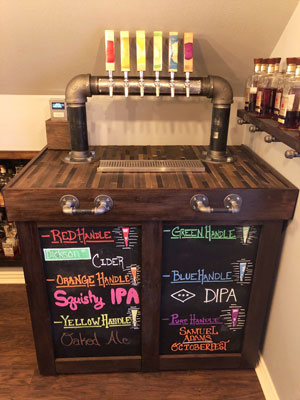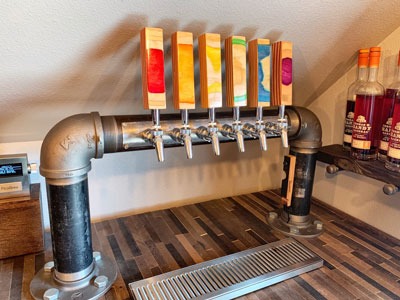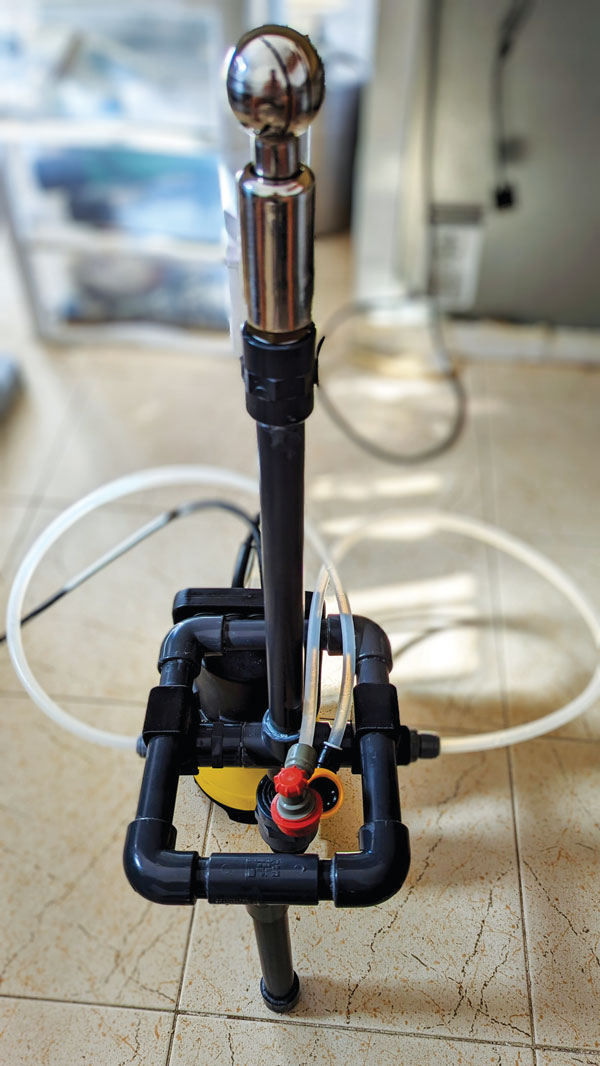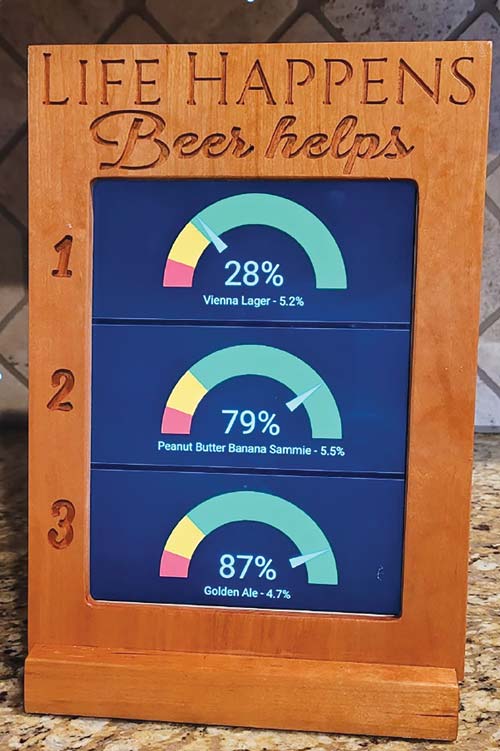Industrial-style Pedestal Tower: Building a tap tower with black pipe

My beer brewing started in 2002 with a Mr. Beer kit. While the Mr. Beer plastic bottles were handy, they weren’t glamorous. So, I added some bottling equipment and bottled a few batches in glass bottles. Unfortunately, the collecting of bottles, multi-step cleaning, and two-week wait for bottles to carbonate were more than I wanted to deal with. I began researching home draft systems. I decided the convenience was worth the investment and bought a nice stainless mini fridge that would fit two corny kegs. I drilled a hole in the top and installed a two-tap tower.
Fast forward about 15 years to 2016. I had slowed my brewing to about twice a year, mostly based on my lack of ability to drink five gallons (19 L) of beer a month by myself. Then I read about the PicoBrew Zymatic®. Fully automated all-grain brewing of 2.5 gallons (9.5 L) at a time. I could get creative again without risking the time and money of brewing five gallons (19 L) of bad beer. This got me into kettle sours, mixed fermentation, oak-aged beers, Brett-only fermentation, and unique styles that I hadn’t tried to brew previously. This sparked a renewed love of brewing and I quickly upgraded to a 20-gallon (76-L) Spike Brewing System. Before I knew it, I was brewing 15 gallons (57 L) every few weekends, splitting the batches into multiple experiments and variations. That old trusty dual tap kegerator just wasn’t cutting it with my new brewing schedule, so I had to go back to bottling. Even with new technology like my Last Straw® Bottle Filler, I still disliked every minute of it. I started looking again at draft ideas and came across the keezer concept. A keezer is a kegerator built out of a chest freezer with an external thermostat to control the temperature.
That old trusty dual tap kegerator just wasn’t cutting it with my new brewing schedule, so I had to go back to bottling.
A quick Google image search will return a massive variety of keezer styles. Those with collars, those with tile towers, those built into bars or walls, and many other varieties. After a bit of planning, I sketched out my concept: A keezer that would hold six 5-gallon (19-L) corny kegs and a 5-lb. (2.3-kg) CO2 tank. The beer lines would go through the top, into both legs of a 3 in. (7.6 cm) black pipe pass-through tap tower that would support six taps. The only minor problem was that I had never done a single wood or metalworking project in my life. Despite this, my lovely wife gave me the thumbs-up. The following is a tutorial of my tower build and some advice to make it easy for you to replicate.
Tools & Materials
- 24 in. (61 cm) of 3-in. (7.6-cm) diameter schedule 40 black pipe (MNPT x MNPT)
- (2) 12 in. (30 cm) of 3-in. (7.6-cm) black pipe (MNPT x MNPT)
- (2) 3-in. (7.6-cm) black pipe elbows (FNPT x FNPT)
- (2) 3-in. (7.6-cm) black pipe flanges (FNPT)
- (8) 3⁄4-in. x 3-in. hex bolts, nuts, and washers
- Custom-rolled sheet metal
- 6-ft. (1.8 m) of 1-in. diameter rubber pipe insulation
- (6) faucets and appropriate draft hardware and beer lines
- (4) mounting bolts (cover plate)
- (2) 1⁄4-in. x 1⁄2-in. thumb screws
- Rope loop and short wood screws
- 5⁄16-in. turnbuckle with eye
- 5⁄16-in. zinc threaded rod, cut to size (mine is 24 in./61 cm long).
- Grinder to cut the black pipe
- Drill and tap kit
- 2 1⁄2–3 in. (6.4–7.6 cm) hole saw
- 1-in. drill bit for the faucets
- Angle grinder
- Drill with 7⁄8-in. drill bit
Step by Step

1. Prepare the Pipe and Cover
The first step is to cut through the black pipe with a grinder so you can run beer line through it and down to the freezer. At first, I tried to cut the pipe with a plasma torch. That created too much collateral damage to the pipe. I cut 16½ in. x 1¾ in. (42 cm x 4.4 cm) to fit six taps. Be sure to center the hole on the pipe so the cover will align correctly.
For the cover, I found an old muffler that I was able to cut a section out of to act as the cover plate. Fortunately, it happened to fit the curvature of the pipe. Alternatively, you can take the black pipe to a local sheet metal shop and ask them to cut you a cover that is 18 in. x 2½ in. (46 cm x 6.4 cm) and roll it to fit the pipe. It doesn’t have to fit the curvature perfectly. Note that you can use shiny sheet metal as is or rough it up with a sander to give it a more rustic look.

2. Drilling and Tapping
I carefully measured and used a drill press to drill a 1-in. (25-mm) hole for each of the six taps in the cover. You will want about 2¾-in. (7-cm) spacing center-to-center for the taps. For an 18-in. (46-cm) long cover and six taps, the first hole’s center point to drill is 2 1⁄8 in. (5.4 cm) in from each end of the cover plate.
To mount the cover to the black pipe, you’ll need to drill four mounting holes in the cover, and drill and tap the black pipe. Start with the cover and drill holes in each corner about ¼ in. (6 mm) in from both edges. Once that’s complete, center it on the black pipe. Use a Sharpie to mark where you need to drill, then drill and tap the black pipe.
Grab the elbows and drill into each of their collars that are facing horizontally. Tap those holes for the thumb screws. The thumb screws will secure the center pipe to be sure it doesn’t rotate when you operate the tap handles.

3. Assemble and Mount the Tower
Assuming the previous steps went well, this one is easy. You won’t be able to assemble the black pipe once the flanges are screwed into the freezer, so start at one flange and put the pieces together until you get to the other flange. Try to screw each piece tightly so there are no spacing issues later.
It’s now time to cut the tap tower holes in the top of your keezer. Assuming you’ve spent some time doing something nice with the freezer (like the keezer top I built), this is really the most nerve-racking part of the project. It was one of those measure ten times, cut once activities. I centered the holes 2⁄3 of the way back on the keezer top and that worked out.
Sit the tower on the top of the keezer, align the flanges and mark where the bolt holes need to be. Remove the tower and drill 7⁄8-in. (22-mm) holes for each ¾-in. (19-mm)bolt. Now, use those holes to find the center mark for the large beer line hole on each side. Cut a 2½-in. to 3-in. (6.4-cm to 7.6-cm) hole with a hole saw for each leg. Once everything is drilled, mount the tower using the ¾-in. (19-mm) bolts, washers, and nuts. Be sure to tighten them well.

4. Install the Draft Equipment
Now that the tower is mounted, run the pipe insulation up through one leg, across, and down the other. The pipe insulation’s primary purpose is to keep the black pipe from sweating. However, as a side benefit, I’ve learned that it keeps me from needing to run glycol. With the pipe insulation, the first ounce of beer is close to room temperature, but by the time you pour a pint, you can’t tell.
Next, work the beer lines through the pipe insulation. Take three lines one direction and three the other. Mount the shanks to the cover and connect them to the beer line. At this point, you can screw the cover onto the black pipe and you’re nearing the finish line.

5. Install a Safety Chain and Prop Rod
The lid will be heavy, and no one wants to be decapitated while changing kegs, so let’s keep that from happening. I had originally thought that the heavy tower would create a lot of leverage to pull the top back too far, so I installed a couple of chains on the inside of the freezer to keep it from breaking off the back. What I learned was that my suspicion was true, but not as early in the opening of the lid as I had thought. Therefore, I needed something to hold the lid up while I worked on the kegs inside. I tried several different contraptions, including hydraulics, but ended up building a simple 5⁄16-in. x 9 3⁄8-in. (8-mm x 24-cm) turnbuckle with a threaded rod that holds it up, like a prop rod for a car’s hood.
The basic instructions are to remove the hook end from the turnbuckle and screw in the threaded rod. Put a rope loop through the turnbuckle’s eye and screw the rope loop into the inside of the freezer somewhere that makes sense. I drilled a small hole in the inside of the freezer lid to secure the prop rod. This will hold the lid up, while the chains keep it from overextending backwards. Problem solved.

6. Finishing Touches
It’s time to wrap this project up. Find or make some nice tap handles (Etsy is a good place to start), grab a drip tray, drop in your kegs and hook everything up. And don’t forget: As with all good beer projects, this one should properly conclude with some consumption.






